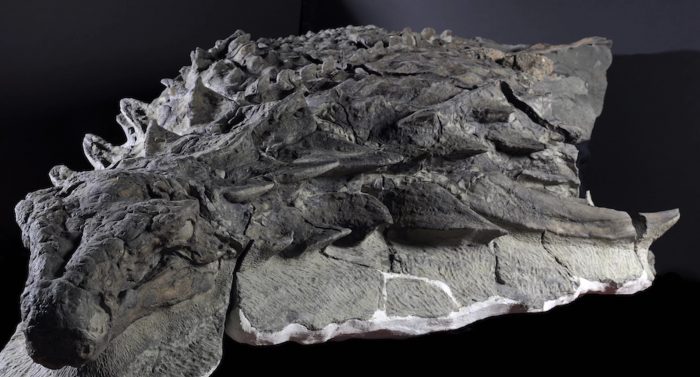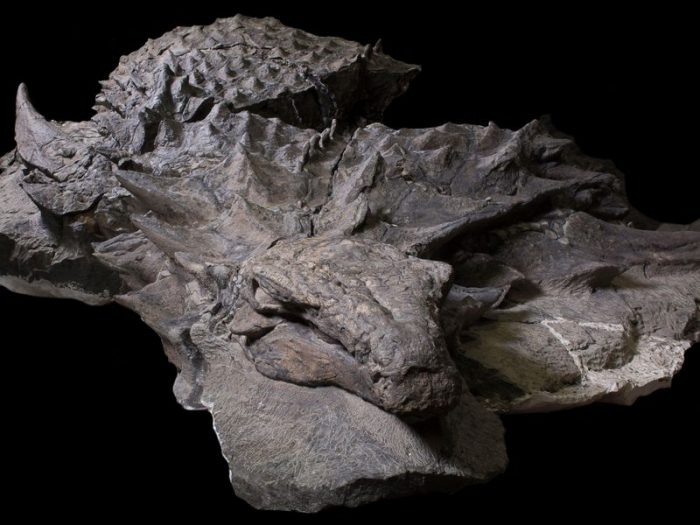When you think about it, any fossil is a remarkable thing. That we can actually find any impressions, bones, or footprints of creatures that lived tens and hundreds of millions of years ago? Pretty mind-blowing stuff.
And yet, the last 150 years of paleontology have found so many fossils that we are able to paint incredible pictures of prehistoric biodiversity (or the complex variety of animals and plants alive at the time). In other words, we don't just know about a few ancient beasts—we know about many thousands of them. You could almost say that we're used to knowing a lot about dinosaurs and their habitat.
Then... BAM! A new fossil arrives out of nowhere to remind us that we really haven't seen anything yet! Already this past week we saw a "baby dragon" and one of the most complete ankylosaur skeletons ever found. Those were impressive, but are you ready to meet...
... a dinosaur mummy?
A fine find in the mine

This exhibit has just opened at the Royal Tyrrell Museum in Drumheller, Alberta. (Courtesy of the Royal Tyrrell Museum)
This is a nodosaurus fossil. It was a cousin of the armoured ankylosaurus—it looked very similar, but did not have that dinosaur's famous clubbed tail. This fossil was discovered in the Suncor Millennium Mine in Alberta in 2011. It took a while to properly extract the remains from the surrounding rock—about five years of careful work by researchers at the Royal Tyrrell Museum in Drumheller, Alberta. But the final result is without question one of the best preserved fossils ever discovered. Have another look...

It's got its eye on you! (Courtesy of the Royal Tyrrell Museum)
The body of this fossil not only still has all of the spikes, horns, and bony plates, it also have many tiny scales and even some sections of skin. These contain enough colour and pattern for scientists to be able to make better guesses than ever before about what this animal looked like when it was alive.
Burial at sea
This nodosaurus is the oldest dinosaur specimen ever discovered in Alberta. It dates back 110 million years, a time when Alberta was as warm as much of Florida and covered by many inland seas. Scientists actually believe that this dinosaur died near the water, before floating out to sea. Eventually, the airs and gases inside the animal's carcass escaped and the body sank to the bottom with a thud. There it was preserved in layers of sediment, or particles of dirt and sand.
The @RoyalTyrrell's #Nodosaur is preserved beautifully, but how? More on its discovery in @NatGeo: https://t.co/v3HeHIzzV5 #TaphonomyTuesday pic.twitter.com/fcrY6X3700
— TheFossilProject (@projectFOSSIL) May 16, 2017
Today, it is on display at the Royal Tyrrell Museum as a part of its Grounds For Discovery exhibit. If you get a chance, we recommend seeing this "one-in-a-billion" dinosaur mummy for yourself!
Contest alert
Don't miss our Science Odyssey Family Contest. Click HERE TO ENTER.
Science Odyssey is a 10-day, Canada-wide celebration of all things science, technology, engineering, and math (STEM). Find activities in your area HERE.
 Is it just asleep? Check out a fossil so intact it almost looks alive! (Courtesy of the Royal Tyrrell Museum)
Is it just asleep? Check out a fossil so intact it almost looks alive! (Courtesy of the Royal Tyrrell Museum)










This is such an amazing site and very interesting information that many people don’t even know about! Bravo for whomever started it. I love reading everything that is published. Keep us updated.
Thx its important in world.
Keep in museum be learn for study
Wow! What an amazing find. Maybe I’ll manage to come see this someday! Thanks for the great article.
this is a great find truly amazing but what about Brachylophosaurus canadensis aka Leonardo. i mean he is also incredibly preserved but which one is more preserved? thank you for the information please reply.